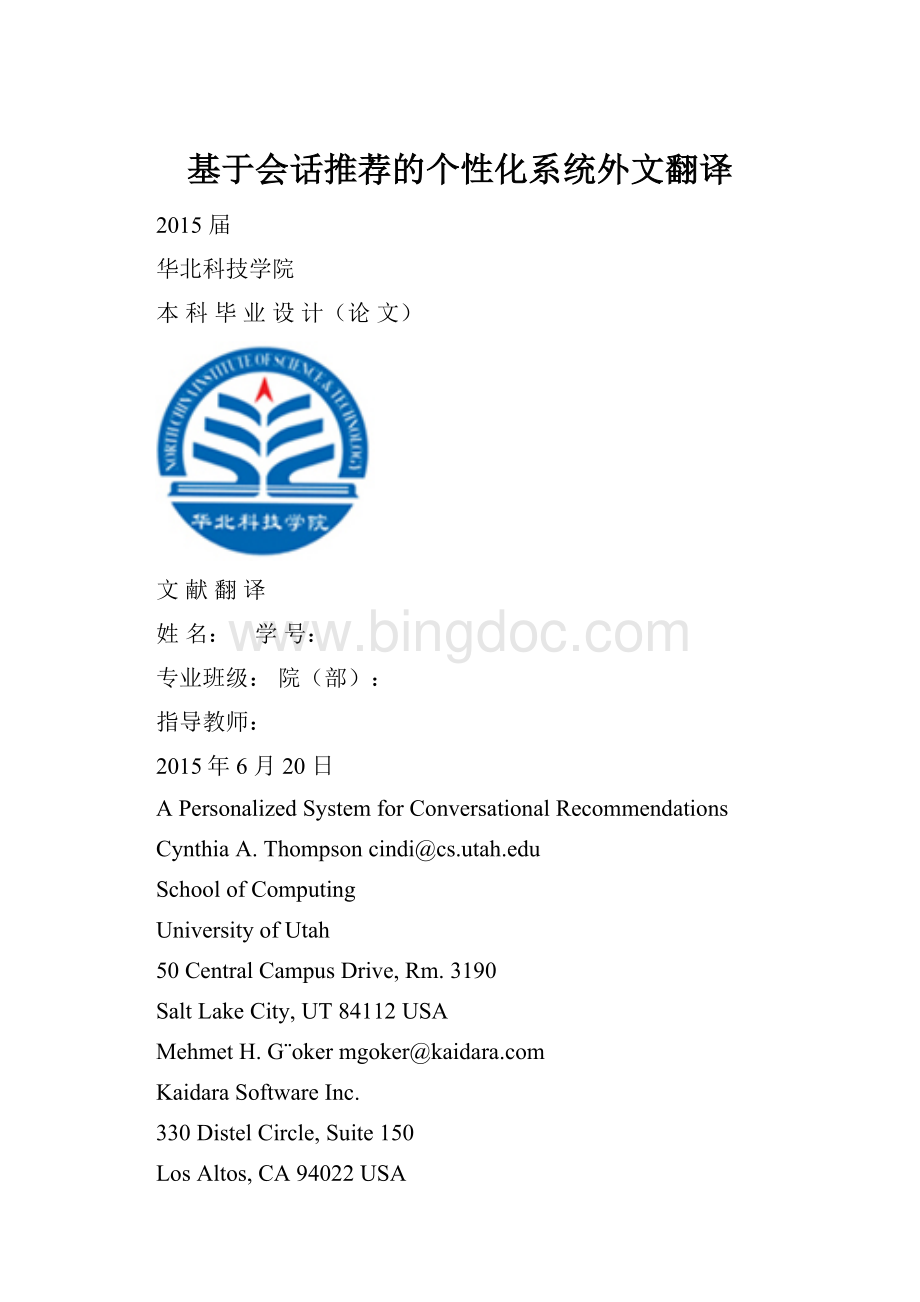基于会话推荐的个性化系统外文翻译.docx
《基于会话推荐的个性化系统外文翻译.docx》由会员分享,可在线阅读,更多相关《基于会话推荐的个性化系统外文翻译.docx(25页珍藏版)》请在冰点文库上搜索。

基于会话推荐的个性化系统外文翻译
2015届
华北科技学院
本科毕业设计(论文)
文献翻译
姓名:
学号:
专业班级:
院(部):
指导教师:
2015年6月20日
APersonalizedSystemforConversationalRecommendations
CynthiaA.Thompsoncindi@cs.utah.edu
SchoolofComputing
UniversityofUtah
50CentralCampusDrive,Rm.3190
SaltLakeCity,UT84112USA
MehmetH.G¨okermgoker@
KaidaraSoftwareInc.
330DistelCircle,Suite150
LosAltos,CA94022USA
PatLangleylangley@isle.org
InstitutefortheStudyofLearningandExpertise
2164StauntonCourt
PaloAlto,CA94306USA
Abstract
Searchingforandmakingdecisionsaboutinformationisbecomingincreasinglydifficultastheamountofinformationandnumberofchoicesincreases.Recommendationsystemshelpusersfinditemsofinterestofaparticulartype,suchasmoviesorrestaurants,butarestillsomewhatawkwardtouse.Oursolutionistotakeadvantageofthecomplementarystrengthsofpersonalizedrecommendationsystemsanddialoguesystems,creatingpersonalizedaides.Wepresentasystem{theAdaptivePlaceAdvisor{thattreatsitemselectionasaninteractive,conversationalprocess,withtheprograminquiringaboutitemattributesandtheuserresponding.Individual,long-termuserpreferencesareunobtrusivelyobtainedinthecourseofnormalrecommendationdialoguesandusedtodirectfutureconversationswiththesameuser.Wepresentanovelusermodelthatinfluencesbothitemsearchandthequestionsaskedduringaconversation.Wedemonstratetheefiectivenessofoursysteminsignificantlyreducingthetimeandnumberofinteractionsrequiredtofindasatisfactoryitem,ascomparedtoacontrolgroupofusersinteractingwithanon-adaptiveversionofthesystem.
1.IntroductionandMotivation
Recommendationsystemshelpusersfindandselectitems(e.g.,books,movies,restaurants)fromthehugenumberavailableontheweborinotherelectronicinformationsources(Burke,1999;Resnick&Varian,1997;Burke,Hammond,&Young,1996).Givenalargesetofitemsandadescriptionoftheuser'sneeds,theypresenttotheuserasmallsetoftheitemsthatarewellsuitedtothedescription.Recentworkinrecommendationsystemsincludesintelligentaidesforfilteringandchoosingwebsites(Eliassi-Rad&Shavlik,2001),newsstories(Ardissono,Goy,Console,&Torre,2001),TVlistings(Cotter&Smyth,2000),andotherinformation.
Theusersofsuchsystemsoftenhavediverse,conflictingneeds.Diffierencesinpersonalpreferences,socialandeducationalbackgrounds,andprivateorprofessionalinterestsarepervasive.Asaresult,itseemsdesirabletohavepersonalizedintelligentsystemsthatprocess,filter,anddisplayavailableinformationinamannerthatsuitseachindividualusingthem.Theneedforpersonalizationhasledtothedevelopmentofsystemsthatadaptthemselvesbychangingtheirbehaviorbasedontheinferredcharacteristicsoftheuserinteractingwiththem(Ardissono&Goy,2000;Ferrario,Waters,&Smyth,2000;Fiechter&Rogers,2000;Langley,1999;Rich,1979).
Theabilityofcomputerstoconversewithusersinnaturallanguagewouldarguablyincreasetheirusefulnessandflexibilityevenfurther.Researchinpracticaldialoguesystems,whilestillinitsinfancy,hasmaturedtremendouslyinrecentyears(Allen,Byron,Dzikovska,Ferguson,Galescu,&Stent,2001;Dybkjfir,Hasida,&Traum,2000;Maier,Mast,&Luperfoy,1996).Today'sdialoguesystemstypicallyfocusonhelpinguserscompleteaspecifictask,suchasplanning,informationsearch,eventmanagement,ordiagnosis.
Inthispaper,wedescribeapersonalizedconversationalrecommendationsystemdesignedtohelpuserschooseanitemfromalargesetallofthesamebasictype.Ourgoalistosupportconversationsthatbecomemoreefficientforindividualusersovertime.Oursystem,theAdaptivePlaceAdvisor,aimstohelpusersselectadestination(inthiscase,restaurants)thatmeetstheirpreferences.
TheAdaptivePlaceAdvisormakesthreenovelcontributions.Toourknowledge,thisisthefirstpersonalizedspokendialoguesystemforrecommendation,andoneoftheonlyconversationalnaturallanguageinterfacesthatincludesapersonalized,long-termusermodel.Second,itintroducesanovelmodelforacquiring,utilizing,andrepresentingusermodels.Third,itisusedtodemonstrateareductioninthenumberofsystem-userinteractionsandtheconversationtimeneededtofindasatisfactoryitem.
Thecombinationofdialoguesystemswithpersonalizedrecommendationaddressesweaknessesofbothapproaches.Mostdialoguesystemsreactsimilarlyforeachuserinteractingwiththem,anddonotstoreinformationgainedinoneconversationforuseinthefuture.Thus,interactionstendtobetediousandrepetitive.Byaddingapersonalized,long-termusermodel,thequalityoftheseinteractionscanimprovedrastically.Atthesametime,collectinguserpreferencesinrecommendationsystemsoftenrequiresformfillingorotherexplicitstatementsofpreferencesontheuser'spart,whichcanbedificultandtimeconsuming.Collectingpreferencesinthecourseofthedialogueletstheuserbeginthetaskofitemsearchimmediately.
Theinteractionbetweenconversationandpersonalizedrecommendationhasalsoaffectedourchoicesfortheacquisition,utilization,andrepresentationofusermodels.TheAdaptivePlaceAdvisorlearnsinformationaboutusersunobtrusively,inthecourseofanormalconversationwhosepurposeistofindasatisfactoryitem.Thesystemstoresthisinformationforuseinfutureconversationswiththesameindividual.Bothacquisitionandutilizationoccurnotonlywhenitemsarepresentedtoandchosenbytheuser,butalsoduringthesearchforthoseitems.Finally,thesystem'srepresentationofmodelsgoesbeyonditempreferencestoincludepreferencesaboutbothitemcharacteristicsandparticularvaluesofthosecharacteristics.Webelievethattheseideasextendtoothertypesofpreferencesandothertypesofconversations.
Inthispaper,wedescribeourworkwiththeAdaptivePlaceAdvisor.Webeginbyintroducingpersonalizedandconversationalrecommendationsystems,presentingourdesigndecisionsalongtheway.InSection3wedescribethesystemindetail,whileinSection4wepresentourexperimentalevaluation.InSections5and6wediscussrelatedandfuturework,respectively,andinSection7weconcludeandsummarizethepaper.
2.PersonalizedConversationalRecommendationSystems
Ourresearchgoalsaretwo-fold.First,wewanttoimprovebothinteractionqualityinrecommendationsystemsandtheutilityofresultsreturnedbymakingthemuseradaptiveandconversational.Second,wewanttoimprovedialoguesystemperformancebymeansofpersonalization.Assuch,ourgoalsforusermodelingdifierfromthosecommonlyassumedinrecommendationsystems,suchasimprovingaccuracyorrelatedmeasureslikeprecisionandrecall.Ourgoalsalsodifierfromthatofpreviousworkinusermodelingindialoguesystems(Haller&McRoy,1998;Kobsa&Wahlster,1989;Carberry,1990;Kass,1991),whichemphasizestheabilitytotracktheuser'sgoalsasadialogueprogresses,butwhichdoesnottypicallymaintainmodelsacrossmultipleconversations.
Ourhypothesisisthatimprovementsinefficiencyandeffectivenesscanbeachievedbyusinganunobtrusivelyobtainedusermodeltohelpdirectthesystem'sconversationalsearchforitemstorecommend.Ourapproachassumesthatthereisalargedatabaseofitemsfromwhichtochoose,andthatareasonablylargenumberofattributesisneededtodescribetheseitems.Simplertechniquesmightsufficeforsituationswherethedatabaseissmalloritemsareeasytodescribe.
2.1Personalization
Personalizeduseradaptivesystemsobtainpreferencesfromtheirinteractionswithusers,keepsummariesofthesepreferencesinausermodel,andutilizethismodeltogeneratecustomizedinformationorbehavior.Thegoalofthiscustomizationistoincreasethequalityandappropriatenessofboththeinteractionandtheresult(s)generatedforeachuser.
Theusermodelsstoredbypersonalizedsystemscanrepresentstereotypicalusers(Chin,1989;Rich,1979)orindividuals,theycanbehand-craftedorlearned(e.g.,fromquestionnaires,ratings,orusagetraces),andtheycancontaininformationaboutbehaviorsuchaspreviouslyselecteditems,preferencesregardingitemcharacteristics(suchaslocationorprice),orpropertiesoftheusersthemselves(suchasageoroccupation)(Kobsa&Wahlster,1989;Rich,1979).Also,somesystemsstoreusermodelsonlyforthedurationofoneinteractionwithauser(Carberry,Chu-Carroll,&Elzer,1999;Smith&Hipp,1994),whereasothersstorethemoverthelongterm(Rogers,Fiechter,&Langley,1999;Billsus&Pazzani,1998).
Ourapproachistolearnprobabilistic,long-term,individualusermodelsthatcontaininformationaboutpreferencesforitemsanditemcharacteristics.Wechoselearnedmodelsduetothedificultyofdevisingstereotypesorreasonableinitialmodelsforeachnewdomainencountered.Wechoseprobabilisticmodelsbecauseoftheirflexibility:
asingleusercanexhibitvariablebehaviorandtheirpreferencesarerelativeratherthanabsolute.Long-termmodelsareimportanttoallowinfluenceacrossmultipleconversations.Also,asalreadynoticed,difierentusershavedifierentpreferences,sowechoseindividualmodels.Finally,preferencesaboutitemsanditemcharacteristicsareneededtoinfluenceconversationsandretrieval.
Oncethedecisionismadetolearnmodels,anotherdesigndecisionrelatestothemethodbywhichasystemcollectspreferencesforsubsequentinputtothelearningalgorithm(s).Herewecandistinguishbetweentwoapproaches.Thedirectfeedbackapproachplacesthe